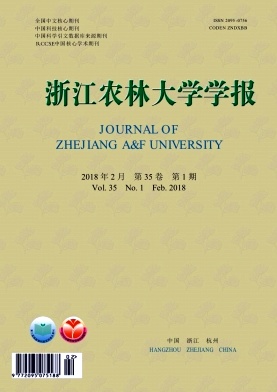-
土壤水是地表水资源的重要形式之一,能够保障陆地植物的生存,同时也是土壤系统养分循环和流动的载体,不但直接影响土壤性质和植物生长,而且间接影响植物分布和小气候的变化[1]。土壤水分的变化对于许多科学和实践活动如地下水补充、气候研究和数值天气预报等以及在特定区域内量化水文、生态和地貌之间的关系中至关重要[2-3]。洪泽湖湿地是唯一分布于北亚热带与暖温带气候过渡带上的大型浅水淡水湖泊湿地,孕育着十分独特的内陆淡水湿地生态系统。杨树Populus spp.是洪泽湖湿地目前最主要的树种,其生长快,适应性强,木材产量高,在湿地的分布面积最大,对湿地生态系统功能产生强烈影响[4-5]。以往围绕干旱或半干旱地区不同植物土壤水分变化的研究较多[1, 6-7],而关于湿地土壤水分的相关研究还不是很充分,特别是洪泽湖湿地在调蓄灌溉与南水北调常态化调水影响下,湖区水位显著波动对土壤水分变化影响的研究还未见报道。土壤水分的空间格局和时间变异受环境因素的强烈影响,在时间尺度上,土壤水分的变化主要受气象因子的调控[8-9]。CHO等[10]研究认为,土壤水分与日平均降水量呈正相关,而与日照、气温和地面温度呈负相关关系;CHEN等[11]研究表明,黄土高原地区土壤水分及其空间、季节和年际变化与降水特征密切相关,而黄志刚等[12]研究南方红壤丘陵区油桐Vernicia fordii人工林土壤水分动态,认为大气相对湿度对土壤蓄水量的贡献最大。从气象环境因子看来,CUI等[13]研究表明,湖泊水位与降水量呈正相关,与逆蒸发和风速呈负相关关系,在洪泽湖气温和湿度等气象因子对该湖区水位影响较大[14]。许秀丽等[15]研究表明,湿地土壤水分受地下水位和湖泊水位的影响。显然,不同区域、不同林分的土壤水分变化及其对气象因子的响应规律并不完全相同。本研究以江苏洪泽湖湿地生态系统国家定位观测研究站典型杨树林为对象,借助涡度相关及土壤水分监测系统,研究湿地土壤-杨树系统水分的时空动态变化特征,解析气象因子的影响,为洪泽湖湿地杨树林水分管理和科学经营与保护提供理论依据。
HTML
-
研究区位于洪泽湖西南部淮河入湖口形成的河湖交汇区。该地区是以老子山镇为中心,由水面及滩涂湿地组成的约为1.47万hm2的区域(33.166°~33.188°N,118.454°~118.692°E)(图 1),受到洪泽湖水体调节,该地区四季分明,年平均气温为14.8 ℃,无霜期为240 d,年平均风速为3.7 m·s-1,有明显的湖陆风,多为偏东风,多年年平均降水量为925.5 mm,雨季多集中在6-9月,降水量占全年65.5%,年蒸发量为1 592.2 mm。试验杨树林位于六道沟地区(图 1虚线圈),为4年生南林95杨无性系Populus × euramericana ‘95’,造林密度为3 m × 4 m,平均树高为8.7 m,平均胸径为7.2 cm。研究区土壤质地为黏壤土。
-
本研究利用英国Delta-t公司生产的PR2/4土壤水分剖面测量系统监测土壤含水量数据,其传感器设置的深度分别为10,20,30和40 cm,间隔2 m设置1根探杆,共计10根。该监测系统间隔30 min自动记录1次。本次研究收集资料的时间为2015年10月到2016年9月。通过洪泽湖湿地杨树林通量观测塔配备的观测系统观测气象因子,其中美国Campbell公司生产的IRGASON和NR01仪器分别测定风速、水汽压亏缺和净辐射,芬兰Vaisala公司生产的HMP155A仪器测定气温和相对湿度,采用HFP01和CS655仪器分别观测土壤深度为8 cm的土壤热通量、潜热通量、感热通量和5 cm处的土壤温度,采用美国HOBO Onset公司生产的RG3-M雨量计观测降水量,其气象因子的观测数据记录的时间均为30 min 1次。以2016年3-6月的气象数据,探索各气象因子对土壤水分的影响。
-
对土壤含水量以及经过质量控制和插补处理后的30 min有效气象因子的观测数据进行日均值和月均值统计。利用Excel 2010和Origin 8.5软件进行数据整理和绘图。采用相关分析方法,利用SPSS 19.0软件进行不同气象因子[日降水量(x1),日平均潜热通量(x2),日平均感热通量(x3),日平均净辐射(x4),平均风速(x5),平均水汽压亏缺(x6),日平均空气温度(x7),日平均相对湿度(x8),日平均土壤热通量(x9)和日平均土壤温度(x10)]与土壤水分的相关分析。为了进一步量化土壤水分与各气象因子之间的关系,利用SPSS 19.0软件将洪泽湖湿地杨树林不同层次土壤水分(y)作为因变量,10个气象因子(x1~x10)作为自变量,做多元逐步回归分析,筛选出有显著影响的气象因子,以此来建立最优回归方程。
1.1. 研究区概况
1.2. 研究方法
1.3. 数据处理及分析
-
图 2可见:在观测深度范围内,年均含水量最小值出现在地下10 cm处,其均值为31.32%±3.48%;最大值出现在地下40 cm处,其均值为47.62%±6.34%。在不同月份中,10 cm和20 cm土壤含水量呈现出“M”型变化,其含水量的第1高峰值分别出现在11月和3月,其值分别为29.69%和33.10%,第2高峰值均出现在7月,其值分别为35.87%和37.59%。相比较而言,30 cm和40 cm土壤含水量呈现出单峰变化,其土壤含水量的峰值均出现在7月,其值分别为47.00%和59.34%。
-
对3月(春)、6月(夏)、9月(秋)和12月(冬)每天各时间点土壤含水量平均值的变化分析可见(图 3):春、夏和冬3季的土壤含水量在0:00-4:30逐渐下降,其最小值均出现在4:30-5:30时左右,其值依次为36.81%±0.61%,43.57%±0.68%和36.43%±0.41%,此后,土壤含水量不断增加,分别于12:30-14:30,18:30和14:00达到峰值,其峰值依次为37.14%±0.80%,44.26%±0.91%和36.64%±0.39%,随后又呈现出逐渐下降的趋势。秋季土壤含水量的日变化明显不同于春、夏和冬3季。土壤含水量在0:00-4:00逐渐上升,在4:00-5:00出现第1峰值,随后下降至8:00达到最小值,第2峰值出现的时间为15:30,其峰值分别为33.09%±1.32%和33.16%±1.46%,随后逐渐下降。
-
5月、8月和9月的土壤含水量在0~20 cm范围内减小,在20~40 cm范围内逐渐增加;而其他月份的土壤含水量在0~40 cm范围内逐渐增加。在0~20 cm深度范围,土壤垂向水分梯度较小,但月份间的差异较为明显;在20~40 cm深度范围,土壤垂向水分梯度较大,且月份间的差异也较为明显,其中冬季垂向水分梯度(28.43%~46.21%)大于夏季(35.81%~56.20%)(图 4)。不同季节垂直剖面土壤含水量大小均为夏季(6-8月)>春季(3-5月)>冬季(12-2月)>秋季(9-11月)。
-
对洪泽湖湿地杨树林土壤水分与各气象因子进行相关性分析表明:在10 cm土壤层次,日降水量、日平均土壤温度、日平均相对湿度和日平均气温与土壤水分达极显著水平,其相关系数分别为0.378,0.549,0.510,0.462(n=116,P<0.01);日平均感热通量、平均风速和日平均土壤热通量与土壤水分达极显著水平,其相关系数分别为-0.482,-0.293和-0.223(n=116,P<0.01),而20,30和40 cm土壤水分均与日降水量、日平均空气温度、日平均相对湿度和日平均土壤温度呈极显著正相关(n=116,P<0.01),与日平均感热通量和平均风速呈极显著负相关(n=116,P<0.01),而与日平均潜热通量、日平均净辐射强度和日平均土壤热通量不相关(表 1)。
土层/cm 气象因子 x1 x2 x3 x4 x5 x6 x7 x8 x9 x10 10 0.378** 0.022 -0.482** -0.175 -0.293** 0.016 0.462** 0.510** -0.223** 0.549** 20 0.240** -0.007 -0.294** 0.044 -0.430** 0.197* 0.485** 0.397** -0.032 0.708** 30 0.203* 0.108 -0.248** 0.020 -0.400** 0.105 0.506** 0.435** -0.109 0.818** 40 0.238** 0.118 -0.238** 0.067 -0.401** 0.220** 0.549** 0.434** -0.083 0.862** 说明:*表示显著(P<0.05),**表示极显著(P<0.01)。 Table 1. Correlation between poplar forest soil moisture and meteorological factors at different soil layer in Hongze Lake Wetland
根据不同层次土壤含水量和各气象因子的测定数据,利用多元逐步回归进一步量化分析,建立相应土壤层次中含水量的最优多元回归方程。经检验,不同层次土壤中的方程均达到了极显著水平(n=116,P<0.01;表 2)。在不同层次土壤中,不同的气象因子被引入逐步回归模型,所引入的气象因子均可在线性模型中解释55.00%以上的土壤水分的总变异。其中,日平均土壤温度对不同层次土壤水分的贡献率分别为20.38%(10 cm),57.97%(20 cm),10.73%(30 cm)和44.31%(40 cm),日平均相对湿度对不同层次土壤水分的贡献率分别为25.12%(10 cm),18.62%(20 cm)和20.88%(30 cm)。总的来看,在所引入的气象因子中,日平均土壤温度和日平均相对湿度对土壤水分的影响更为明显。
土层/cm 多元回归方程 R2 F值 P值 贡献率/% 10 y1=30.181+0.265x10-0.083x3+0.043x8-3.605x6+ 0.013x4 0.579 30.252 < 0.001** x10(20.38),x3(21.06),x8(25.12),x6(22.27),x4(11.17) 20 y2=26.9+0.388x10-0.017x2+0.017x8 0.589 53.427 < 0.001** x10(57.97),x2(24.11),x8(18.62) 30 y3=36.461+0.377x10-7.543x6+0.579x7-0.097x8-0.045x1-0.147x9-0.548x5 0.810 65.779 < 0.001** x10(10.73),x6(17.16),x7(38.07),x8(20.88),x1(5.01),x9(4.55),x5(3.60) 40 y4=36.158+0.896x10-0.342x9-0.026x2+0.06x3-0.747x5+0.06x7 0.839 94.749 < 0.001** x10(44.31),x9(18.48),x2(12.07),x3(9.81),x5(8.45),x7(6.88) 说明:*表示显著(P<0.05),**表示极显著(P<0.01)。 Table 2. Stepwise regression analysis between poplar forest soil moisture and meteorological factors at different soil layer in Hongze Lake Wetland
2.1. 土壤水分的动态变化特征
2.1.1. 月动态变化特征
2.1.2. 日动态变化特征
2.1.3. 垂直动态变化特征
2.2. 气象因子对土壤水分变化的影响
-
土壤水分受多重尺度上的土地利用(植被)、气象、地形、土壤、人为活动等众多因子的影响,具有明显的时空尺度特征[2-3, 8, 10, 16]。研究发现,洪泽湖湿地杨树林0~20 cm土壤水分的年内动态变化呈现出“M”型变化,变化相对明显。这与一些学者的研究结果存在差异,究其原因,可能是因为表层土壤首先接收穿透雨和凋落物截留后的渗水,同时又受到降水和太阳辐射等外界气象因子的影响较大,所以更容易受地表蒸发和植物根系耗水的影响[17-18],如土壤水分峰值出现在降水量较大的月份(6月、7月和11月)(图 2),也有可能是因为不同种类的植物、气候条件和土壤质地对土壤水分的影响不同[3, 19];而20~40 cm土壤水分的年内动态变化呈现出单峰变化,可能是因为气象因子对深层土壤水分的影响相对较小所致[17-18],这与许秀丽等[15]研究结果一致。王贺年等[20]将北京山区林地土壤水分动态分为稳定期、消耗期、积累期和消退期等4个阶段,本研究中稳定期在10-2月,土壤含水量为31.36%~36.07%(均值34.44%),其原因可能在于10月以后,区域气温较低,杨树生长缓慢,其蒸腾和土壤蒸发减少,并且湖区水位稳定,该时间段内土壤水分处于稳定状态;消耗期在3-4月,土壤含水量为36.64%~37.46%(均值37.05%),进入3月以后,气温开始逐渐升高,杨树蒸腾和土壤蒸发增加。杨树叶芽开始萌动,芽苞逐渐增大伸长,使得土壤水分消耗较大,尽管该时间内降水也相对较大(占总降水量的8.22%),土壤水分有所补充,但总体看来,土壤含水量在20 cm土壤深度表现下降趋势,表明有所消耗,但消耗期表现不明显;积累期在5-7月,土壤含水量为39.22%~53.92%(均值42.55%),气温开始大幅度升高,杨树蒸腾和土壤蒸发也增强,但降水量也主要集中在该段时间内(占总降水量的64.84%),对土壤水分有明显的补充,这使得土壤含水量得到积累;消退期在8-9月,土壤含水量为40.38%~32.92%(均值32.29%),8月下旬开始,气温虽然开始降低,但杨树蒸腾和土壤蒸发还较高,杨树枝条长度生长停止,进入越冬准备期,而且降水量迅速降低,使得土壤含水量进入消退期。
杨建伟等[21]研究表明:杨树的耗水高峰随着土壤水分含量的不同而出现的时间也发生相应的变化。本研究表明,杨树林土壤水分在春、夏和冬3季的日变化曲线呈单峰型特征,在4:30-5:30达到最小值,在12:30-14:00达到最大值,而秋季土壤水分的日变化呈现不对称双峰曲线特征,其峰值出现的时间分别为4:00-5:00和15:30。秋季土壤水分的日变化与其他3季不同,可能是因为秋季植物根系白天从土壤中吸收水分,晚上根系向其周围土壤释放水分[22],导致夜间土壤水分也会出现峰值。土壤含水量清晨最低、午后最高的波动变化与黄土高原地区、古尔班通古特沙漠[23-24]的4季以及酒泉金塔地区[25]夏季的观测结果一致,而与武汉地区[26]土壤水分的日动态变化的观测结果相反。杨树土壤水分呈现出夜间逐渐降低,白天逐渐上升的波形变化的原因,可能是由于土壤水分主要来自对气态水的凝结和吸附作用,而水汽运动的方向受温度梯度的驱动,从而使水分发生运移所导致的[23, 27]。
何其华等[1]研究认为:在干旱和半干旱地区,土壤含水量从上到下的变化趋势分为增长型和降低型(先增后减)2种变化趋势。本研究表明:洪泽湖湿地杨树林土壤水分随着土层深度的增加,其含水量逐步递增,这与HUANG等[28]对丹江口水库地区的土壤水分研究结果相一致。对该地区土壤垂直剖面水分的研究表明:土壤冬季水分梯度大于夏季,剖面土壤含水量均是冬季大于秋季,这与许秀丽等[15]对鄱阳湖典型湿地土壤垂直剖面水分的研究结果不同,其原因在于洪泽湖属于水库型湖泊,冬季关闸蓄水,湖区水位较秋季有所上升,使得深层土壤水分经历了短期的地下水浅埋对土壤水分的充分补给过程,剖面水分含量较大[29]。
土壤水分受多种气象因子的综合调控,土壤和空气温度的变化不仅可以改变土壤水分能态及其有效性[30],还能影响土壤水分的保持[31],提高水分的扩散能力并加剧其流失,降雨可以增加大气相对湿度和土壤水分含量,平均风速、净辐射和水汽压亏缺等气象因子还能影响土壤水分的蒸散[32]。CHO等[10]研究表明:土壤水分与日平均降水量呈正相关关系,与日照、气温和地面温度呈负相关关系。本研究表明:不同深度的土壤水分受气象因子的影响有差异,但总体来看日降水量、日平均空气温度、日平均相对湿度、日平均土壤温度与土壤水分呈极显著正相关关系,与日平均感热通量、平均风速与土壤水分呈极显著负相关关系。本研究与CHO等[10]的研究结果不尽相同,一方面可能与研究的地域(如湿地、干旱和半干旱地区)不同有关,还可能与研究的尺度大小以及时间有关[33-34]。仅通过相关分析无法准确判断出气象因子对土壤水分产生影响的重要程度,由此引入多元逐步回归分析。日平均土壤温度和日平均相对湿度与土壤水分的关系最为密切,其他引入的气象因子也会对不同层次土壤水分产生影响,这与CHEN等[11]和黄志刚等[12]研究结果不尽相同。造成分析结果不同的原因除了试验的地区和时间不同外,还可能与所选择的分析方法不同有关。
洪泽湖地区地下水位较高,杨树林在生长过程中基本没有进行灌溉,而土壤水分的季节性变化可能会导致杨树生长季的缺水,例如华北平原地区杨树的生长会受到春旱的影响[35]。井大炜等[36]研究表明:干旱会导致光合效率降低,加剧活性氧代谢的失调,最终抑制杨树幼苗生长。在杨树生长期降水过多而造成的渍害会导致湿地杨树林出现淹水情况,而淹水胁迫会引起弱光环境,使植物气体扩散受限,叶片细胞膜脂过氧化加剧,体内保护酶系统受损,叶绿素降解,丙二醛含量积累,光合速率下降,从而影响杨树生长发育[37]。由此可见,干旱、渍水等极端气象灾害会严重影响杨树的生长发育。洪泽湖建闸后,为保证洪泽湖防洪调蓄和农田灌溉,每年自8-9月至翌年4月须关闸蓄水,水位升高;夏初为防洪灌溉需开闸放水,导致湖泊水位急剧降低,这与其他湖泊的水位变化不同。因此,为了避免夏季水位低造成土壤水分补给不足以及冬季水位高出现渍害情况的发生,建议在栽植杨树时进行开沟、条垄栽植。
-
受降水等气候因子和湖区水位的共同影响,洪泽湖湿地杨树林土壤水分的年内变化可以大致分为稳定期(10-2月)、消耗期(3-4月)、积累期(5-7月)和消退期(8-9月),但其中的消耗期表现不明显。
不同季节杨树林土壤含水量的日变化特征有所差异:春、夏和冬3季的土壤含水量的日变化曲线呈单峰型特征,而秋季土壤水分的日变化呈不对称双峰曲线特征。
土壤水分变化与降水量、气温、相对湿度、土壤温度、感热通量和风速密切相关。其中,日平均土壤温度和相对湿度是影响洪泽湖湿地杨树林土壤水分变化的最主要气象因子。











 DownLoad:
DownLoad:


